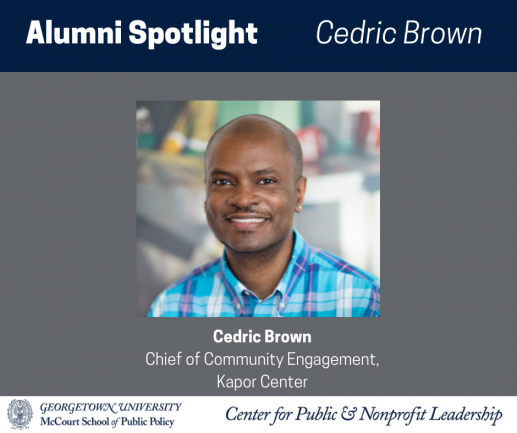Alumni Spotlight: Cedric Brown, Kapor Center

To learn more about leadership in the Nonprofit sector please join us for our open house on March 27th.
The Kapor Center is a nonprofit organization that aims to make the technology ecosystem and tech entrepreneurship in the United States more diverse and inclusive. The Kapor family of organizations works to remove barriers to Science, Technology, Engineering and Math (STEM) education and tech careers for people of color underrepresented in the tech sector. The Kapor Center takes a comprehensive approach to fixing the leaks at every stage of the tech pipeline, from education to workplaces to entrepreneurship. They engage in programs and initiatives, advocacy, and social impact investing. The Center for Public and Nonprofit Leadership spoke with alumnus Cedric Brown, Chief of Community Engagement at Kapor Center, about his experiences working in the nonprofit sector and his time in CPNL’s Nonprofit Management Executive Certificate Program.
This interview has been lightly edited for clarity
Center for Public and Nonprofit Leadership (CPNL): Why did you want to work in the nonprofit sector?
BROWN: I have always felt like the nonprofit sector was the place for folks who wanted to do direct work around the betterment of other people and the Earth. When I started my career, I thought the corporate sector was all about profit taking precedence over anything else. I am starting to see that change now, but in the beginning it was a no-brainer for me. The nonprofit sector has always aligned with my deep belief in the betterment of society.
CPNL: How did you get your current job?
BROWN: I was trained as an educator, and worked at a middle school in San Francisco for several years. I then had the opportunity to work and eventually run a small grant for teachers’ program at our local education fund. That turned me on to grant-making as a strategy for being able to invest small dollars in ideas that other people had to see if there could be a more significant impact in their community. From there, I went to the San Francisco Foundation, where I gained a great deal of knowledge around nonprofit/philanthropy work. I then started working with Freada Klein, the co-founder of Kapor Center, and long story short, I asked Freada and her partner Mitch Kapor if I could run their family foundation, and they said yes! I wanted the position because having a partnership with living donors in a smaller funding organization could lead to more tailored initiative work at a quicker pace than working at a larger foundation.
It has been a unique and wonderful opportunity for me, working all these years at the Kapor Center.
CPNL: What is the most fulfilling part of your current role?
BROWN: What is most fulfilling in my current role is the knowledge that providing resources and access actually works. When people can get information and resources that they need, they can take another step toward their own empowerment, bringing their own brilliant ideas to life. I feel like that happens frequently, and I love it. I also have the benefit and pleasure of working with a team of great people who work diligently on our mission.
CPNL: What accomplishment are you most proud of?
BROWN: My biggest accomplishment is helping to build an institution that serves a larger community. Over my career I’ve helped to start initiatives, share a lot of advice with our partners, and steered financial capital to very worthy efforts. I am most proud of my part of building the Kapor Center into what it is today.
CPNL: What was your biggest takeaway from the Nonprofit Management Executive Certificate
program?
BROWN: I think understanding the number of skills and areas in which an executive director needs to have proficiency was the biggest takeaway I gained from the program. The way the program was structured when I took the course in 2009 was very effective. We spent a day on different areas of work (communications, fundraising, budgeting, etc.) and getting those quick overviews with compelling speakers and going through all the foundational principles was very helpful for me.
CPNL: How has the Certificate Program helped you in your career?
BROWN: My participation in the certificate program broadened my overall understanding of how to operate an organization, soup to nuts. It was useful to me not only as an executive leader, but as a board member to other nonprofits as well. My capstone project focused on the restructuring of an organization while I was board chair, and the information I learned from the Certificate Program was a great guide!
CPNL: What advice would you give to other professionals who are considering participating in the Certificate Program?
BROWN: Do it! I believe potential participants must examine the skills that they want to build upon, and try to match those skills to what the program offers. That way, people can feel like they are coming away from the program having had an enriching experience.
